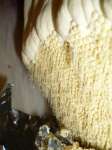|
On Fri, Aug 14, 2015 at 7:07 PM, Weaver, Bill (NorCal DCIS Team Lead) wrote:
And stranger still, it was not dried first. It was frozen 'fresh' as I was told for titanium pollen, "if it dries it dies".
-----Original Message-----
From: aroid-l-bounces@www.gizmoworks.com [mailto:aroid-l-bounces@www.gizmoworks.com] On Behalf Of Tom Croat
Sent: Friday, August 14, 2015 3:38 PM
To: 'Discussion of aroids'
Subject: Re: [Aroid-l] Amorphophallus pollen request
Dear Bill:
Thank you so much for your good advice. I am astonished that it will last so long. I would think such temperatures would cause it to break to pieces.
Tom
-----Original Message-----
From: aroid-l-bounces@www.gizmoworks.com [mailto:aroid-l-bounces@www.gizmoworks.com] On Behalf Of Weaver, Bill (NorCal DCIS Team Lead)
Sent: Friday, August 14, 2015 3:24 PM
To: Discussion of aroids; aroid-l@gizmoworks.com
Cc: 'btankers@chicagobotanic.org'
Subject: Re: [Aroid-l] Amorphophallus pollen request
Pretty straight forward. At the end of the first day install foil trays above the female flowers and below the male flowers. (see attached) overnight the male flowers will produce pollen that can then be swept into the trays and the trays removed at the end of the day.
The pollen should then be packaged and frozen and kept as cold as it can be. The pollen from the 2005 blooming of Trudy at UC Berkeley was kept in a DNA freezer at 80 degrees F below zero and was fully viable two years later when applied to Titania in 2007.
-----Original Message-----
From: aroid-l-bounces@www.gizmoworks.com [mailto:aroid-l-bounces@www.gizmoworks.com] On Behalf Of Tom Croat
Sent: Thursday, August 13, 2015 4:39 PM
To: aroid-l@gizmoworks.com
Cc: 'btankers@chicagobotanic.org'
Subject: [Aroid-l] FW: Amorphophallus pollen request
Dear All: I am in Ecuador with poor connections. Could someone please advise my old friend Boyce Tankersly how he can best save and share pollen of A. titanium with others?
Tiom
-----Original Message-----
From: Boyce Tankersley [mailto:btankers@chicagobotanic.org]
Sent: Wednesday, August 12, 2015 4:32 PM
To: Tom Croat
Subject: Amorphophallus pollen request
Hi Tom:
The Amorphophallus titanum at Chicago Botanic Garden is coming into bloom and we would like to collect pollen to share with other institutions. Can you provide any insight into the best approach to take and store (long term) the pollen?
Many thanks,
Boyce Tankersley
Director of Living Plant Documentation
Chicago Botanic Garden
1000 Lake Cook Road
Glencoe, IL 60022
Email: btankers@chicagobotanic.org
Phone: 847-835-6841
Fax: 847-835-1635
-----Original Message-----
From: Nancy Ruth Morin [mailto:Nancy.Morin@NAU.EDU]
Sent: Wednesday, August 12, 2015 12:00 PM
To: AABGACOL@LIST.MSU.EDU
Subject: Re: Amorphophallus pollen request
Hi Boyce! You might ask Tom Croat at MO at least about the pollen collecting.
Nancy Morin
Flora of North America Business Office
P. O. Box 716
Point Arena, CA 95468
707/882-2528
________________________________________
From: Boyce Tankersley [btankers@CHICAGOBOTANIC.ORG]
Sent: Wednesday, August 12, 2015 9:51 AM
To: AABGACOL@LIST.MSU.EDU
Subject: Amorphophallus pollen request
Greetings:
The Amorphophallus titanum at CBG is about to come into flower and we would like to pollinate the flowers. Does anyone have pollen that they can share with us? Full bloom in a couple of days or so.
Related request, does anyone have experience collecting pollen from Amorphophallus that they could share?
Many thanks,
Boyce Tankersley
Director of Living Plant Documentation
Chicago Botanic Garden
1000 Lake Cook Road
Glencoe, IL 60022
Email: btankers@chicagobotanic.org
Phone: 847-835-6841
Fax: 847-835-1635
_______________________________________________
Aroid-L mailing list
Aroid-L@www.gizmoworks.com
http://www.gizmoworks.com/mailman/listinfo/aroid-l
_______________________________________________
Aroid-L mailing list
Aroid-L@www.gizmoworks.com
http://www.gizmoworks.com/mailman/listinfo/aroid-l
_______________________________________________
Aroid-L mailing list
Aroid-L@www.gizmoworks.com
http://www.gizmoworks.com/mailman/listinfo/aroid-l
--001a1149369ea5d1cd051d8812be--
--==============�79477537369440296==
| 


